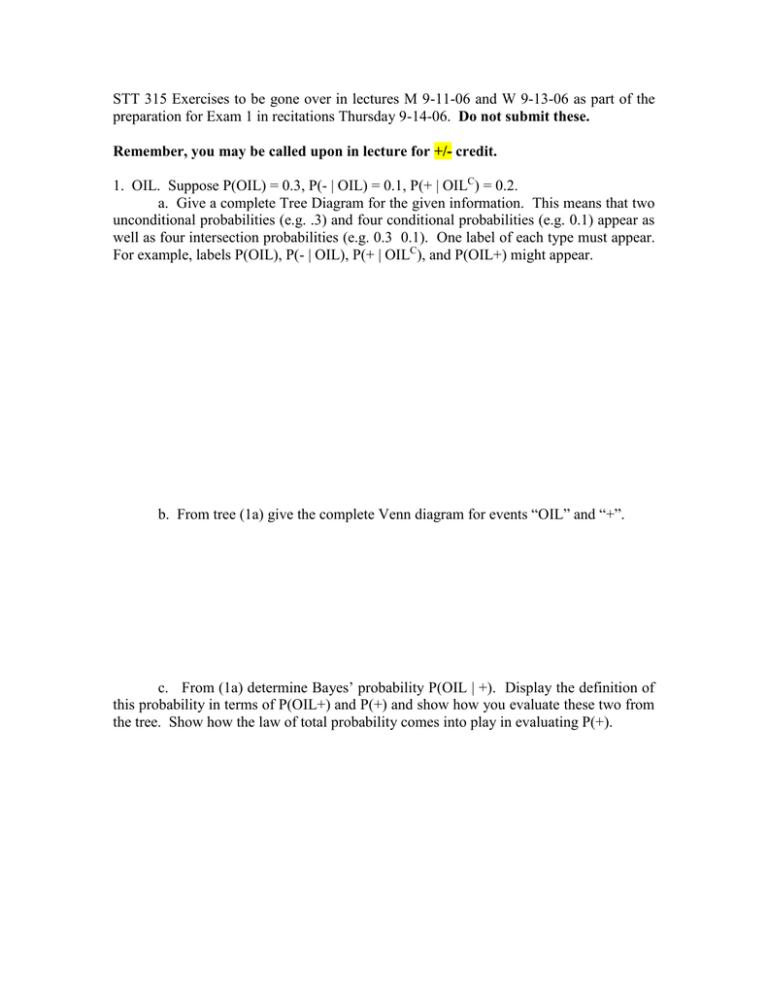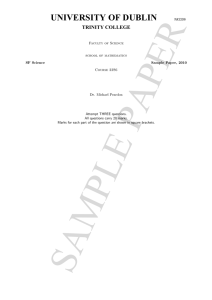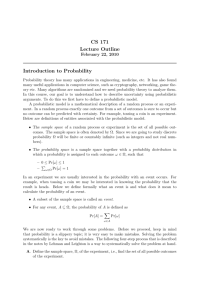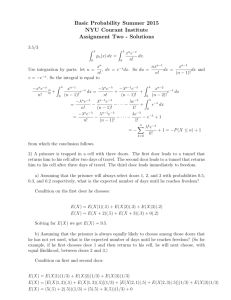STT 315 Exercises to be gone over in lectures M... Do not submit these.
advertisement

STT 315 Exercises to be gone over in lectures M 9-11-06 and W 9-13-06 as part of the
preparation for Exam 1 in recitations Thursday 9-14-06. Do not submit these.
Remember, you may be called upon in lecture for +/- credit.
1. OIL. Suppose P(OIL) = 0.3, P(- | OIL) = 0.1, P(+ | OILC) = 0.2.
a. Give a complete Tree Diagram for the given information. This means that two
unconditional probabilities (e.g. .3) and four conditional probabilities (e.g. 0.1) appear as
well as four intersection probabilities (e.g. 0.3 0.1). One label of each type must appear.
For example, labels P(OIL), P(- | OIL), P(+ | OILC), and P(OIL+) might appear.
b. From tree (1a) give the complete Venn diagram for events “OIL” and “+”.
c. From (1a) determine Bayes’ probability P(OIL | +). Display the definition of
this probability in terms of P(OIL+) and P(+) and show how you evaluate these two from
the tree. Show how the law of total probability comes into play in evaluating P(+).
d. In the Venn diagram (1b) shade the sample space that comes into play when
we obtain the conditional probability P(OIL | +). Cross hatch the part of the event “OIL”
that resides within this new (smaller, and conditional) sample space.
e. Should P(OIL | -) be smaller or larger than P(OIL | +) and why? Confirm your
reasoning by calculating P(OIL | -).
2. Another OIL problem has the following probabilities for the end branches of its tree:
OIL+ 0.3
OIL- 0.1
OILC+ 0.2
OILC-
Fill out the last line above and a complete tree diagram for this information.
3. Refer to (2). Suppose it costs 40 to test, 150 to drill, and the gross return from OIL is
900 (oil must be there and we must drill otherwise the gross return is zero). Determine E
X where random variable (r.v.) X denotes the NET return from the policy “drill, do not
test.” Be sure to calculate values x and p(x) for the two contingencies. Show all terms
contributing to each value x.
OIL
OILC
4. Refer to (2). Suppose it costs 40 to test, 150 to drill, and the gross return from OIL is
900 (oil must be there and we must drill otherwise the gross return is zero). Determine E
Y where random variable (r.v.) Y denotes the NET return from the policy “test, but drill
only if the test is +.” Be sure to calculate values y and p(y) for the four contingencies.
Show all terms contributing to each value y. You need not give the tree.
OIL+ 0.3
OIL- 0.1
OILC+ 0.2
OILCSome people think that larger expectation is more desired. Which policy, X or Y, has the
larger expectation?
5. Refer to (4). Suppose testing costs rise to 70. Then E Y is no longer valid. Let W
denote the net return from the policy “test, but drill only if the test is +” in the situation of
the greater testing cost. Write an equation expressing W in terms of Y. Use that
equation to evaluate E W from E Y (without re-figuring everything as was done in (4)).
6. Events A, B are disjoint. Prepare a Venn diagram for P(A) = 0.4, P(B) = 0.3.
Identify the correct formulas and determine each of
P(AB) =
P(A intersection B) =
P(A and B) =
P(A union B) =
P(A or B) =
P(A | B) =
P(B | A) =
7. Events A, B are independent. Prepare a Venn diagram for P(A) = 0.4, P(B) = 0.3.
Identify the correct formulas and determine each of
P(AB) =
P(A union B) =
P(A | B) =
P(B | A) =
P(B | not A) =
P(B | not B) =
8. For events A, B we are given P(A) = 0.5, P(B | A) = 0.2, P(B) = 0.4. Prepare a Venn
diagram.
9. Refer to (8). Prepare a tree diagram with A, AC forming the initial (left) branching
and B, BC forming the downstream branches after each of A, AC.
10. For events A, B we are given P(A) = 0.5, P(B | A) = 0.7, P(B) = 0.4. Is this possible,
why?
11. A box contains colored balls [ R R R R G G G Y Y Y Y Y ]. Balls will be
withdrawn without replacement and with equal probability for those remaining.
a. P(R1) =
b. P(R2) = (naive answer, no calculation)
c. Calculate P(R2) using total probability and multiplication rules.
d. P(R2 | R1) = (naive answer, no calculation)
e. P(R1 | R2) = (naive answer, no calculation)
f. If many people independently reproduce this ball selection experiment and 400
of them have R2, around how many people participated in the experiment?
g. Refer to (e). If many people independently reproduce this ball selection
experiment and 400 of them have R2, around how many of those 400 have R1?
h. P(R1 G2 R3 Y4 G5) =
i. P(R1 G2 R3 Y4 G5 G6 G7) =
12. John’s dad has gene type Aa. John’s mom is also type Aa for that same gene.
According to Mendelian principles, what is the probability John will be type aa?
13. There is a concept of randomly expressed gene. As applied to (12) it would say that
if John is not aa he will have a “usual” characteristic. If John is type aa the theory instead
says John will have the less usual characteristic. Determine P(John has the less usual
characteristic). (break it down according to what his parents give him, its the same old
total probability and multiplication rule thing).
14. Refer to (13). What is P(John is aa | John has the less usual characteristic)? No
calculation is required.
15. P(diseased) = 0.0005 (rare), P(+ | diseased) = 0.98 (desirably close to one), and P(- |
not diseased) = 0.99 (also desirably close to one). It seems that this test should be good
at detecting diseased individuals. We might think that P(diseased | +) ~ 1.0, but is it?
What is going on? Does anything like this happen in business?
16. Sketch five normal curves with mean 100 and standard deviation 15, and shade in
them regions with the respective areas:
84%
95%
05%
(47.5-34)%
50%
Identify numerically the points of the horizontal axis defining these regions.
17. An ATM machine has a random outward cash flow modeled as a random variable
X. We know that E X = 25 and the standard deviation of X is 60. This large standard
deviation suggests that the possible individual transaction amounts x are (at least some of
them) fairly widely spread apart. Consider the sum T = X1 + X2 + ..... + X800 of 800
independent ATM transactions.
a. E T
b. Variance X = Var X =
c. Var T =
d. standard deviation of T = sd T =
e. Sketch the approximate distribution of T. Does the total cash outflow T show
much random variation relative to what is expected on average for T?
f. Determine a numerical interval within which there is ~ 95% chance T will be.
18. A random sample of 100 of a firm’s shippers is scored for x = amount they each
expect to spend on energy next fiscal year. These scores are found to have sample mean
xBAR = 97,220 and sample sd s = 22,000. Give numerical answers to the following:
a. What is our estimated value for the population mean x-score for all of our 1200
shippers?
b. What is our estimated value of the standard deviation sigma for the entire list
of our 1200 shippers?
c. What is our estimated value of the standard deviation of the random variable
xBAR?
d. What is the (estimated) margin of error for xBAR?
e. What is the approximate value of P(mu is within xBAR +/- ME)? Here mu
refers to the true population mean x-score for all of our 1200 shippers.
f. If the sample of 100 is instead made without replacement from our 1200
shippers we are entitled to a smaller ME using the FPC. Give this smaller ME.
19. For the list of x-scores {8, 2, 2} calculate
a. xBAR
b. s = (take the square root)
c. If y = 3 x – 4 what are yBAR and s (for y-scores)? Use the rules.
20. Given the probability distribution
x
p(x)
3
0.2
5
0.4
9
0.4
Calculate the numerical values of
a. E X =
b. Var X =
c. sd X =
21. (0-1 scores, dichotomy) The probability distribution
x
p(x)
1
p = 0.4
0
q = 0.6
is obviously special since scores x are 0 or 1 only. Notice that 02 = 0 and 12 = 1. Only
zero and one have this property. For any p = p(1) and q = p(0) it is true that E X = p and
sd X = root(pq). Confirm that this is so for the particular case p = 04 and q = 0.6 above.
A proof of the result is:
E X = 0 p(0) + 1 p(1) = 0 q + 1 p = p (so proportions are averages for 0-1 scoring)
E X2 = E X = p (since X2 = X for X taking only the values x = 0 or x = 1).
Var X = E X2 – (E X)2 = p – p2 = p (1-p) = pq
The above simple results are used in every dichotomy, e.g.:
x = 1 if
x = 0 if
male
female
dem
rep
diseased
not diseased
aged 17-21
not aged 17-21
pos outlook
neg outlook
It is the basis for the (estimated) margin of error for pHAT:
+/- 1.96 root(pHAT qHAT) / root(n)
For example, if there are 36 males in a random sample of 80 persons we report:
pHAT +/- ME = 36/80 +/- 1.96 root(36/80 44/80) / root(80)
Theory says
P(p within pHAT +/- ME) ~ 0.95
where p is the fraction of males in the population.
Interpret this as follows:
We’ve sample a random n = 80.
Around 95% of samples of n = 80 produce pHAT +/- ME covering p.
Our sample of n = 80 gives
36/80 +/- 1.96 root(36/80 44/80) / root(80)
however, we do not know if our sample was one of the 95% of sample of n = 80.
22. (Diversify?) Our point can be made with an over-simplified example. We’ve a
choice between three mutually independent investments A, B, C. Each has the same
expected return (on one dollar invested) of 1.3 with sd 0.4. Compare the expected return
and sd of return for:
FOCUSED FUND: invest $300 in A
DIVERSE FUND: invest $100 each in A, B ,C
Aside from the comparison of standard deviations of returns, made above, investing $300
in FOCUSED FUND could result in a highly non-normal distribution of return. Investing
$300 DIVERSE FUND would be closer to normal return in a variety of circumstances
but we are not prepared to discussed that here. Non-normal returns are complex to
evaluate.
Normal returns are easy to evaluate if we have an idea of the mean and sd of total return.
23. Red and Green dice are thrown. Determine:
E (1 / R) =
ER=
E R2 =
Var R =
sd R =
E(R + G) =
Var(R + G) = (are R and G independent?)
sd(R + G)
E(7 R – 2 G + 14)
Var(7 R – 2 G + 14)
sd(7 R – 2 G + 14)
24. Let X, Y be random returns on a one dollar investment for each of two consecutive
months. If the return X of the first month is invested in Y then the return overall is the
product XY. If X, Y are independent (many models for the markets take the view that
this is so) determine E(XY) if E X = 1.005, E Y = 1.003. Notice that XY is the same if
instead E X = 1.003 and E Y = 1.005. In fact there are “automatic” investment portfolios
(more complicated than simply jumping between investments since they allow money to
flow among investments) that produce exactly the same returns even if the market moves
are interchanged in time. Not all portfolio management schemes in use have this
property. Those that do make the same money in boom after bust as they do in bust
followed by boom (identical moves shuffled in time). All of this ignores transaction
costs, inflation, etc.
25. Three doors problem, for discussion. This caused a lot of grief when Marilyn vos
Savant published a column in which she related an analysis of the following problem.
Lots of people who wrote her, and had their comments quoted in later columns, surely
wish they had not done so. Google the whole affair if you wish to learn the details.
My abstraction of the essential assumptions of the problem (a problem which made the
rounds long before Marilyn’s column) follows.
There are three doors behind only one of which is a major prize.
Prizes do not change during the game.
A “contestant” is invited to “choose a door” (not opened until the game ends).
The “host” opens one of the two other doors, showing no major prize behind it.
The host offers the contestant the opportunity to switch to the door not yet in play.
The contestant gets whatever is behind their door (of those two).
In her column, Marilyn quoted probability 2/3 that a person who always switches would
settle on the door with the major prize behind it.
The assumption that the host opens one of the other two doors, showing no major prize is
behind it, is apparently not correct for the game show Let’s Make Deal (see below)
although many times it seems to have operated that way.
As for the 2/3, an “always switch” contestant fails to win only if the major prize is behind
their originally chosen door. So 2/3 is certainly correct for an “always switch” contestant
who chooses their original door at random. Likewise, a “never-switch” contestant wins
with probability 1/3 if they too chose a door at random to begin with.
A surprising number of reasonably visible professionals seem to have gone on record
with comments about this that take issue with the 2/3 answer, but without specifically
isolating and attacking the assumptions made explicit above.
There are subtleties to the problem, some of which make this answer less than complete.
For example, (skipping the obvious possibility of bias in the location of the best prize) the
host might be falling into some little habits (twisting on his shoe, glancing at the ceiling,
indulging zippy contestants?) that offer clues (statistical associations as to) where the
major prize is. In that case we may perhaps increase our probability of winning, from an
already hefty 2/3, by taking those clues into account at the time of the offer to switch
doors. This does not violate the assumptions but introduces the element of overlooked
information.
More seriously, prizes may change during the game, which contradicts the second of our
assumptions. Arbitrarily changing the value of prizes behind a door being offered, or
behind a door having been refused or abandoned, or increasing the value of what is
behind a door being held unseen, should be considered. Allowing prizes to change
during the game, in such a way that the contestant is never disadvantaged by the changes,
alters the game entirely, enabling the host to be very entertaining indeed, even to the
extent of suggesting that stupendous prizes were within grasp when they never were, or
making a winner out of a person who has chosen badly. It makes 2/3 irrelevant since a
host could, as he chooses (either after the fact or in the middle of things) locate the best
prize either with the contestant or not.
In this context you cannot justify a 2/3 probability that the switcher wins what the
audience, at the conclusion of the game, is made to understand was the best prize.
You could claim 2/3 in relation to some dynamically evolving prize values but that gets
completely murky since they might start low and increase at the whim of the host.
Here is the original exchange with a reader of vos Savant’s
column taken from http://www.marilynvossavant.com/articles/gameshow.html
“Game
Show Problem
(This material in this article was originally published in PARADE magazine in 1990
and 1991.)
Suppose you're on a game show, and you're given the choice of three
doors. Behind one door is a car, behind the others, goats. You pick a
door, say #1, and the host, who knows what's behind the doors, opens
another door, say #3, which has a goat. He says to you, "Do you want to
pick door #2?" Is it to your advantage to switch your choice of doors?
Craig F. Whitaker
Columbia, Maryland
Yes; you should switch. The first door has a 1/3 chance of winning, but
the second door has a 2/3 chance. Here's a good way to visualize what
happened. Suppose there are a million doors, and you pick door #1.
Then the host, who knows what's behind the doors and will always
avoid the one with the prize, opens them all except door #777,777. You'd
switch to that door pretty fast, wouldn't you?”
Here is an excerpt from http://plus.maths.org/issue5/puzzle/solution.html
“Monty Hall
This problem has been around for many years. A similar problem was
published in Scientific American about 40 years ago. The author,
Martin Gardner, went on to say that "in no other branch of
mathematics is it so easy for experts to blunder as in probability
theory".
This observation couldn't have been closer to the truth. Although the
problem was picked up in 1975 and published in the American Statistician
it did not become famous until 1990 when Marilyn vos Savant,
reputedly the most intelligent person in the world, wrote about it in
the American Parade Magazine.
In her column she described an American TV game show called Let's
Make a Deal in which the compère, Monty Hall, presents the contestant
with three doors. Behind one of them is a car, behind the others a
goat. Once the contestant has chosen a door Monty Hall opens one of
the other two doors to reveal a goat and then offers the switch.
Marilyn was inundated with thousands of letters, many from
professional mathematicians, disputing her solution. Feelings ran so
high that eventually Monty Hall himself became involved. It turns out
that in the real show he wasn't obliged to offer the switch at all. If the
contestant chose a door with a goat he might open it straight away -
too bad! Even if he did offer the switch, he would use bribes to trick
the contestant into taking the goat. "They'd think the odds on their
door had now gone up to 1 in 2, so they hated to give up the door no
matter how much money I offered." he said.
Still, if these ambiguities seem like an excuse then think again. People
still get the problem wrong, even when it is stated carefully. The
problem has spread from one discussion forum to another, it has
appeared in numerous places on the Internet and has recently been
discussed in the British magazine New Scientist and even featured in
the Royal Institution Christmas lectures televised in December.
If there's one thing about probability theory that is certain, it's that the
Monty Hall puzzle will be making fools of people for many years to
come.”








